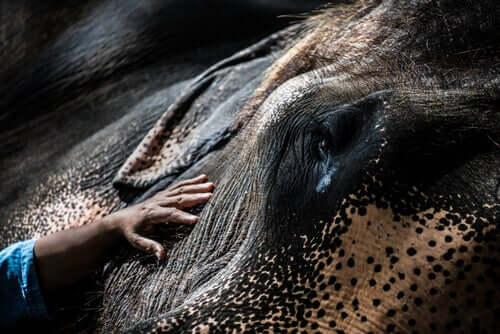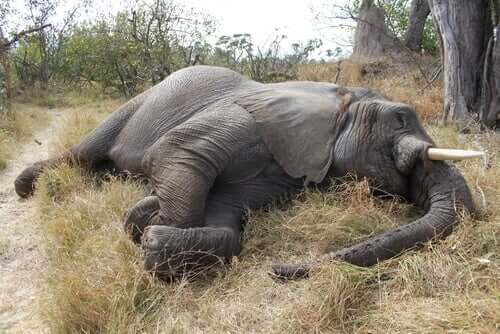5 Viral Infections that Can Affect Elephants


Written and verified by the vet Érica Terrón González
For many years, both for their build and constitution, elephants have been associated with health and longevity. However, they too can become ill. To show you, we’ll tell you about 5 viral infections that can affect elephants living in captivity.
The truth is that no living creature is exempt from becoming sick at some point in its life.
Elephant endotheliotropic herpesviruses (EEHV)

Elephant endotheliotropic herpesviruses (EEHV), or Elephantid betaherpesvirus 1 (ElHV-1), produces infections in the majority of mammal species. The definitive hosts of this virus–African elephants–are very seldom affected in a serious way. But the intermediary hosts–Asian elephants–do suffer from this illness.
Transmission and symptoms
The herpesvirus enters through the respiratory airway, and lodges in the pulmonary nodules in an asymptomatic manner. Animals that become ill experience lethargy, anorexia, and colic. Later on, edemas in the head, trunk, and the front extremities may appear.
The real problem occurs when this illness becomes more serious, causing hemorrhagic wounds, which are usually fatal.
5 viral infections that can affect elephants: Encephalomyocarditis
This is a natural illness in rats, which act as a natural reservoir. But the most serious forms affect many other mammals, both wild and domestic. Among them, both the African and the Asian elephant.
The virus that causes this illness is a cardiovirus, from the Picornaviridae family. It replicates itself in the myocardial cells, producing such damage in the tissue that it ends up destroying the cells.
Transmission and symptoms
This infection normally occurs by means of the fecal-oral route, through contaminated foods or water. However, it can’t spread from one elephant to another.

Foot-and-mouth disease
In the case of foot-and-mouth disease, we’re looking at a very contagious, but rarely fatal, viral infection. The problem is that it affects livestock massively, which is why the aim is to eradicate it. When it comes to wild animals, this infection affects both ruminating and non-ruminating animals, including elephants living in captivity.
The agent that causes the foot-and-mouth disease is from the Picornaviridae family.
Transmission and symptoms
The transmission of this virus is respiratory or through direct contact with infected animals or objects.
This is an infection that causes vesicular and erosive lesions on the mucous membranes of the mouth and on the skin of the infected animal’s extremities. The incubation period lasts about 5 days, at which point the animal starts to feel depressed and feverish. From then on, clinical signs begin to appear in the mouth, including an increase of salivation and even the appearance of pus.

Smallpox
Smallpox is another one of the viral infections that can affect elephants. It’s characterized by swelling of the skin and mucous membranes of the entire body. This swelling gets worse over time, leading to the appearance of painful pustules and ulcers.
The virus that causes smallpox is an Orthopoxvirus sp, and can be considered a zoonosis that affects both humans and animals. In fact, experts believe that its origin in elephants derives from their use as a way of attracting children in European zoos.
Elephants tend to suffer consequences that vary from a simple eye conjuntivitis to a systemic illness that ends up being fatal.
5 viral infections that can affect elephants: rabies
The virus that causes this serious illness is a Lisavirus, which belongs to the Rhabdoviridae family. It exists throughout the entire planet and can affect almost any species of mammals.
Transmission and symptoms
The transmission of rabies occurs through contact with the saliva of an infected animal with the blood of another. In other words, it normally spreads as the result of a bite. The main reservoirs of this virus are carnivores and bats.
An elephant affected by rabies will start to show mild symptoms and then progress towards an absolute change in behavior. At first, there will be excitation and aggressiveness, disorientation, and a lack of coordination. Then, the animal will move onto the paralytic stage, which may lead to a comatose state. Finally, the neural damage will be so great that the animal will end up dying.
Differential diagnosis
In order to make a proper diagnosis, veterinarians must differentiate rabies from any other neurological illness. For example, tetanus or botulism. At the same time, they must rule out problems that affect the central nervous system, such as hard blows or gunshot wounds.
For many years, both for their build and constitution, elephants have been associated with health and longevity. However, they too can become ill. To show you, we’ll tell you about 5 viral infections that can affect elephants living in captivity.
The truth is that no living creature is exempt from becoming sick at some point in its life.
Elephant endotheliotropic herpesviruses (EEHV)

Elephant endotheliotropic herpesviruses (EEHV), or Elephantid betaherpesvirus 1 (ElHV-1), produces infections in the majority of mammal species. The definitive hosts of this virus–African elephants–are very seldom affected in a serious way. But the intermediary hosts–Asian elephants–do suffer from this illness.
Transmission and symptoms
The herpesvirus enters through the respiratory airway, and lodges in the pulmonary nodules in an asymptomatic manner. Animals that become ill experience lethargy, anorexia, and colic. Later on, edemas in the head, trunk, and the front extremities may appear.
The real problem occurs when this illness becomes more serious, causing hemorrhagic wounds, which are usually fatal.
5 viral infections that can affect elephants: Encephalomyocarditis
This is a natural illness in rats, which act as a natural reservoir. But the most serious forms affect many other mammals, both wild and domestic. Among them, both the African and the Asian elephant.
The virus that causes this illness is a cardiovirus, from the Picornaviridae family. It replicates itself in the myocardial cells, producing such damage in the tissue that it ends up destroying the cells.
Transmission and symptoms
This infection normally occurs by means of the fecal-oral route, through contaminated foods or water. However, it can’t spread from one elephant to another.

Foot-and-mouth disease
In the case of foot-and-mouth disease, we’re looking at a very contagious, but rarely fatal, viral infection. The problem is that it affects livestock massively, which is why the aim is to eradicate it. When it comes to wild animals, this infection affects both ruminating and non-ruminating animals, including elephants living in captivity.
The agent that causes the foot-and-mouth disease is from the Picornaviridae family.
Transmission and symptoms
The transmission of this virus is respiratory or through direct contact with infected animals or objects.
This is an infection that causes vesicular and erosive lesions on the mucous membranes of the mouth and on the skin of the infected animal’s extremities. The incubation period lasts about 5 days, at which point the animal starts to feel depressed and feverish. From then on, clinical signs begin to appear in the mouth, including an increase of salivation and even the appearance of pus.

Smallpox
Smallpox is another one of the viral infections that can affect elephants. It’s characterized by swelling of the skin and mucous membranes of the entire body. This swelling gets worse over time, leading to the appearance of painful pustules and ulcers.
The virus that causes smallpox is an Orthopoxvirus sp, and can be considered a zoonosis that affects both humans and animals. In fact, experts believe that its origin in elephants derives from their use as a way of attracting children in European zoos.
Elephants tend to suffer consequences that vary from a simple eye conjuntivitis to a systemic illness that ends up being fatal.
5 viral infections that can affect elephants: rabies
The virus that causes this serious illness is a Lisavirus, which belongs to the Rhabdoviridae family. It exists throughout the entire planet and can affect almost any species of mammals.
Transmission and symptoms
The transmission of rabies occurs through contact with the saliva of an infected animal with the blood of another. In other words, it normally spreads as the result of a bite. The main reservoirs of this virus are carnivores and bats.
An elephant affected by rabies will start to show mild symptoms and then progress towards an absolute change in behavior. At first, there will be excitation and aggressiveness, disorientation, and a lack of coordination. Then, the animal will move onto the paralytic stage, which may lead to a comatose state. Finally, the neural damage will be so great that the animal will end up dying.
Differential diagnosis
In order to make a proper diagnosis, veterinarians must differentiate rabies from any other neurological illness. For example, tetanus or botulism. At the same time, they must rule out problems that affect the central nervous system, such as hard blows or gunshot wounds.
All cited sources were thoroughly reviewed by our team to ensure their quality, reliability, currency, and validity. The bibliography of this article was considered reliable and of academic or scientific accuracy.
- Fowler M, Mikota S. Biology, Medicine, and Surgery of Elephants. Hoboken: John Wiley & Sons; 2008
This text is provided for informational purposes only and does not replace consultation with a professional. If in doubt, consult your specialist.








